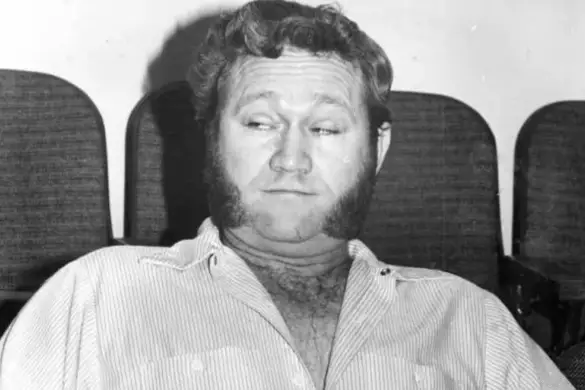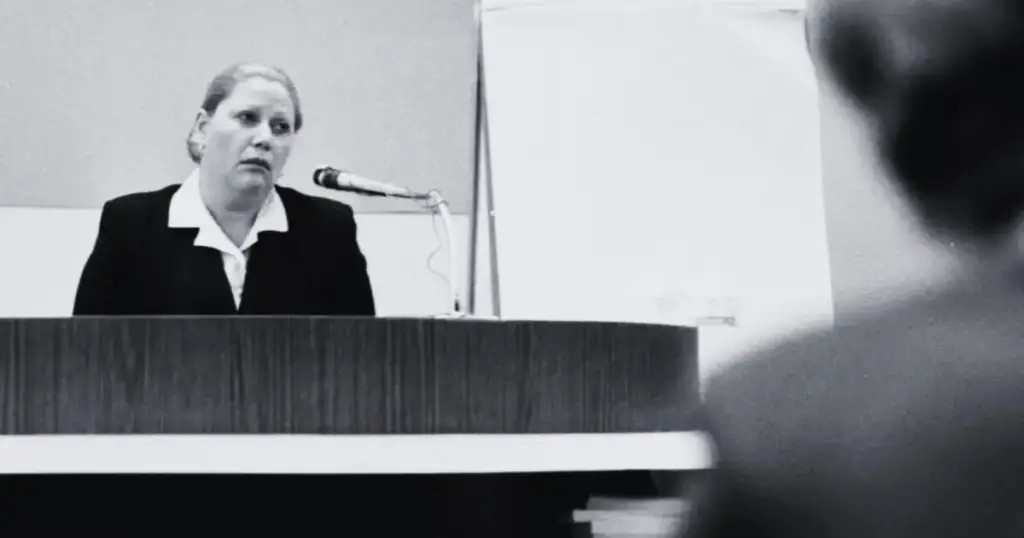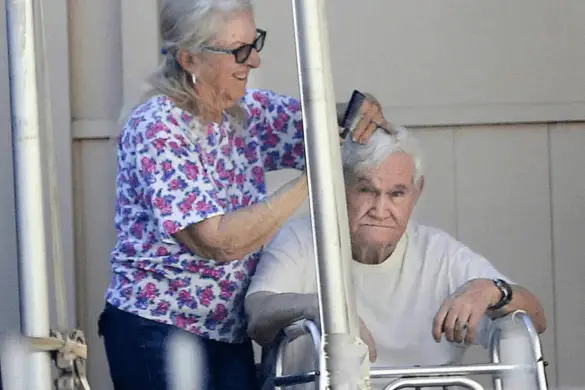In 1978, Sol and Marilyn Sayegh resided in Las Vegas, Nevada, with their three children. Sol, then 33, owned a large carpet firm called Carpet Barn, providing the close-knit family with a wealthy lifestyle.
But unimaginable tragedy would strike, ultimately tearing this loving family apart.
Sol and Marilyn’s six-year-old son, Cary Daniel Sayegh, attended Albert Einstein Hebrew Day School, a private school and now a charter school, at 1600 East Oakey Boulevard.
On October 25, 1978, Cary was getting ready for school when his mother put on his shoes and tied the shoelaces. Marilyn said goodbye to her son as he walked out the door. That was the last time Marilyn saw her sweet little boy.
Cary disappeared from his school’s playground at lunchtime. His classmates told authorities that he entered a vehicle on the school’s property.
Three hours later, an unidentified male telephoned the Sayeghs. A neighbor, Geraldine Blutter, who was at Sol and Marilyn’s house with the family, answered the phone.
In a low, gravelly voice, a man said, “I’ve got your kid.” The caller assumed Geraldine was the boy’s mother, according to 1978 reports.
Early reports also state the man demanded $500,000, but police revealed in 2018 that the actual amount was $350,000 in exchange for Cary’s safe return. The man told Sol and Marilyn he would call back in two days with specific instructions regarding the ransom payment. However, he never phoned again.
And so began one of the most exhaustive searches in Southern Nevada history. It involved 50 FBI agents, which, at that time, was the most significant number of agents to work a single case in Las Vegas.
Rio Lacanlale, Las Vegas Review-Journal
The Sayeghs made a public plea five days after their son’s kidnapping and offered a $50,000 reward for information leading to Cary’s safe return.
“We beg you, please don’t hurt him, we haven’t seen him in so many days,” pleaded Marilyn.
A few months before his son’s abduction, Sol, then 33, attempted to expand into the gaming business. Authorities arrested Sol and two other men – Joe Daly, 40, a San Bernardino cemetery salesman, and Jack L. Gordon, 39, a hotel concessionaire – in August 1978.
At the time of Cary’s abduction, the three men were facing trial in a federal court for attempting to bribe the Nevada Gaming Commission Chairman Harry Reid. The men were developing a new type of coin-operated gaming device and were striving to get it quickly approved for use in the state’s casinos.
Retired Federal Prosecutor Tom O’Connell told the Review-Journal in 2020: “Jerald Burgess would approach Sol Sayegh about his indictment and offer to ‘take care of’ Harry Reid for him. He was summarily dismissed from the Sayegh home.”
Following Cary’s kidnapping, the courts delayed Sol’s trial due to the horrific circumstances. In February 1980, at the request of then-U.S. Attorney Mahlon Brown, the charges against Sol were dismissed, citing Sol had suffered dramatically over his son’s kidnapping. Several months before, a federal jury found the other two men guilty, and a judge sentenced them to six months in jail.
Investigators ruled out Sol and Marilyn, and other family members in Cary’s disappearance. They focused on Burgess, who had a strange story to tell.
Jerald Howard “Jerry” Burgess

At the time of Cary’s disappearance, Burgess was in his early 40s. Shortly before the boy vanished, Burgess had sexually assaulted a woman on the property of Cary’s school.
According to The Charley Project, Cary’s classmates identified Burgess as the man driving the unidentified vehicle that day. Burgess admitted to being there but claimed he delivered lunch to his girlfriend’s son, a friend of Cary’s. Additional witnesses also identified Burgess’s voice as that of the unidentified caller demanding the ransom.
Burgess told investigators where they could find one of Cary’s shoes – at a desert wash along Pecos-McLeod Interconnect. However, he gave a bizarre story that Cary’s kidnappers gave him the information, and he acted as a go-between with them and the Sayegh family.
On top of being an accused rapist and a suspect in Cary’s disappearance, Burgess was a con man.
On December 12, 1978, police charged him with sexual assault. Two days later, a grand jury indicted Burgess on charges of defrauding a Texas couple out of $200,000 by allegedly telling them they were buying interest in a Las Vegas Strip hotel-casino operation. Burgess received a concurrent 15-year prison term for the fraud and sexual assault charges.
Trial With ‘No Body’

In March 1981, a Clark County grand jury indicted Burgess on first-degree kidnapping charges and obtaining money under false pretenses in Cary’s kidnapping. He went to trial in 1982. Burgess said he believed Cary was alive and living overseas in Israel. However, he failed to provide evidence supporting his claim.
Witness Testimonies
Several people testified at the trial, identifying Burgess as the man on the playground and as the voice of the caller.
Geraldine testified that she recognized the caller’s voice as Burgess’s.
Shortly after the ransom call, authorities used a voice expert to analyze the recording. That person testified that there is a “big probability the unknown voice and the voice of the defendant are the same,” news reports stated.
Both Sol and Marilyn testified. During Sol’s testimony, he said that Burgess told him he had put $25,000 under a garbage can for the alleged abductor and wanted the money back.
Burgess said that he had put “feelers out on the street” for Cary, and the kidnappers had contacted him on a pay phone, saying they wanted $25,000 in “good faith money.”
Sol testified: “He said he would send Stevie Paul (Burgess’s girlfriend) over to get $32,000 from me. He said he had to have $32,000 that day or lose the house he was buying for her.”
Stevie arrived “within a minute” of the phone call, and Sol gave her a check for the $32,000.
Bonnie Kaufman was the playground supervisor the day Cary disappeared. She testified that she had seen Burgess on the school grounds talking to the boy before his classmates saw him enter the vehicle.
A former business partner of Burgess testified that he saw Burgess minutes after the abduction in a car on Sahara Avenue near Eastern Avenue, about a mile from the school. It looked like a child was sitting inside.
Unbelievably, the jury acquitted Burgess of all charges in February 1982, stating there was insufficient evidence to convict.
One juror, Randy Goodwill, who was 22 then, told the Review-Journal in 2001: “I never heard anything that the prosecutors presented to me that would lead him to be guilty.”
WTF? Did he not believe the witness testimonies?
In 1982, years before DNA, a witness’s statement was often considered credible when there was no physical evidence to support a defendant’s guilt. But for some wild reason, the jury seemingly disregarded the testimonies.
Burgess was released in 1989.
21 Years After Cary’s Disappearance
Fast forward to 1999. Burgess remained a suspect in Cary’s abduction. That year, authorities received a tip that Cary was living in Boston, Massachusetts, sometime in the 1990s. The information sparked a renewed investigation, hoping to find Cary’s body, and investigators came up with a clever ruse to make that happen.
Burgess unknowingly sold a .22-caliber pistol with a silencer and ammunition to an undercover agent. The deal was arranged through an FBI informant. Burgess discussed the disposal of bodies and said he could get rid of one by placing it in a steel drum filled with acid and welding it shut.
The informant then asked Burgess to help him dispose of a body. Burgess agreed for $250,000.
During the undercover operation, an FBI agent posed as a dead man in the trunk of the informant’s car.
Burgess met the informant and an undercover FBI agent on July 31, 2000. During that meeting, the Review-Journal reported at the time, the two sought assurance from Burgess that he would put the body with Cary’s. Burgess said Cary’s body would be close by, but he did not disclose a location. Rio Lacanlale, Las Vegas Review-Journal
Rio Lacanlale
Burgess never revealed where he disposed of Cary’s body, and authorities never charged him in the kidnapping. The FBI arrested Burgess on weapons charges. As a person with felony convictions, he was not allowed to possess firearms or ammunition. Burgess was sentenced in 2002 to 11 years in prison and released in 2013.
AFTERMATH
In June 1999, Sol Sayegh, then 54, pleaded guilty in District Court to drawing and passing bad checks in connection with gambling debts he amassed in 1997, reported the Las Vegas Sun. The judge ordered him to pay off nearly $7 million or face four years in prison. Sol owed money to the Caesars Palace, Desert Inn, Palace Station, and Las Vegas Hilton hotel casinos.
Cary’s parents divorced several years ago. As far as I can tell, Sol is still in Vegas, but his mother and siblings moved away, I believe.

Burgess is now 86 and also lives in Vegas. His wife of more than 30 years, Phyllis Burgess, has stood by her man. *Cue Tammy Wynette* But she likely KNOWS where he buried Cary and what her hubby did to the boy before his death. She could not be married to him for this long and NOT know. This man has lived a long life, and half of that life he has spent gloating over killing Cary by remaining silent about what happened to him or where he disposed of Cary’s body. It is appalling, to say the least.
Cary remains missing, and his case is officially unsolved.
Sources
Arnold, Patrick. “Man Under Fraud Indictment Material Witness in Kidnapping.” Reno Gazette-Journal. December 15, 1978.
“Bribery Charges Filed.” Reno Gazette-Journal. August 1, 1978.
Good, Meaghan. “Cary Daniel Sayegh.” The Charley Project. https://charleyproject.org/case/cary-daniel-sayegh
Hawley, Tom. “SPECIAL REPORT: Where’s Cary?” News 3 Las Vegas. February 11, 2020. https://news3lv.com/news/local/special-report-wheres-cary
“Kidnap Charge Reported.” Reno Gazette-Journal. March 5, 1981.
“Kidnap Victim’s Father Testifies.” Reno Gazette-Journal. January 21, 1982.
Lacanlale, Rio. “Las Vegas Boy’s Kidnapping Case Remains Open, 40 Years Later.” Las Vegas Review-Journal. October 20, 2018. https://www.reviewjournal.com/crime/las-vegas-boys-kidnapping-case-remains-open-40-years-later/
Macy, Robert. “Father of Kidnap Victim Faces $7 Million in Casino Debts.” Las Vegas Sun. June 11, 1999. https://lasvegassun.com/news/1999/jun/11/father-of-kidnap-victim-faces-7-million-in-casino-/
“No Response to Parents’ Plea in Vegas Kidnapping. Reno Gazette-Journal. October 31, 1978.
“Vegas Bribery Charge Dismissed.” Reno Gazette-Journal. February 28, 1980.
“Vegas Couple Begs for Return of 6-year-old Kidnapped Son.” Reno Gazette-Journal. October 30, 1978.



